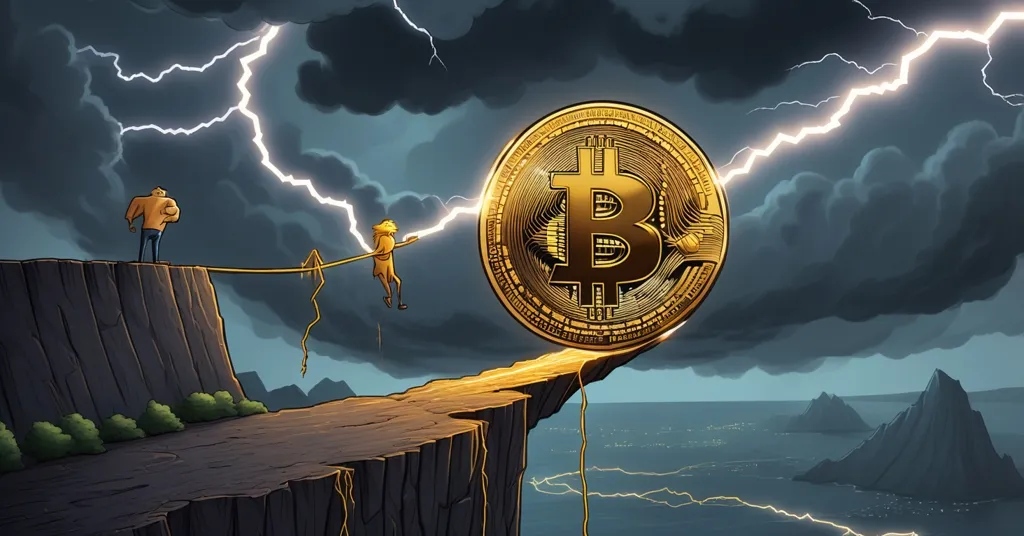Bitcoin Hits $100,000: Bloomberg Expert Warns of ‘Do or Die’ Stress Test

Bitcoin at $100,000: ‘Do or Die’ Stress Test, Warns Bloomberg Expert
Bitcoin has smashed through the $100,000 barrier, a milestone that should have the crypto crowd roaring with excitement. Yet, Bloomberg Intelligence’s senior commodity strategist Mike McGlone is sounding the alarm, calling this a “do or die” moment and warning of “extreme complacency” in the markets. This isn’t a victory lap—it’s a brutal stress test that could shape Bitcoin’s future as the ultimate decentralized asset or send it tumbling back to earth.
- Pivotal Price Point: Bitcoin at $100,000 is a critical threshold, testing its maturity and staying power.
- Market Calm Hides Risk: Low volatility across Bitcoin and traditional markets signals a dangerous complacency, per McGlone.
- Downside Danger: Failing to hold this level risks a drop to its long-term average of $56,000.
McGlone’s Warning: Extreme Complacency at $100,000
Mike McGlone isn’t pulling punches with his take on Bitcoin’s current state. He describes the market as steeped in “extreme complacency,” a term that might sound tame but carries heavy weight, as highlighted in a recent analysis by Bloomberg’s top expert. For those unfamiliar, complacency in finance means investors are too cozy, ignoring risks because things seem stable. Right now, Bitcoin’s price action is oddly serene, unable to punch past $110,000 despite hitting the six-figure mark. At the same time, traditional markets are also showing eerie calm. The S&P 500, a key benchmark for U.S. stocks, and the Cboe Volatility Index (VIX)—often called the “fear gauge” or market mood meter—are at historic lows. The VIX’s 50-week average sits around 19, a level that typically screams smooth sailing but often precedes chaos. Think of the calm before the 2008 financial crash—this kind of quiet can be a trap.
McGlone’s point is blunt: this stillness isn’t peace; it’s a coiled spring ready to snap. Low volatility in any market, crypto or not, often means a big move is coming, up or down. For Bitcoin, sitting at $100,000, the stakes couldn’t be higher. This isn’t just ignorance on display—it’s a dangerous blind spot for investors riding high on recent gains.
“Bitcoin’s $100,000 line is not a victory lap anymore — it is a stress test.”
Bitcoin’s Achilles Heel: Still Tied to Wall Street
One of Bitcoin’s biggest selling points is its “digital gold” narrative—a decentralized safe haven free from the whims of traditional finance. But let’s cut the fluff: the data tells a different story. Bitcoin’s correlation with the S&P 500 remains stubbornly high at over 0.53. To break that down, a correlation near 1 means two assets move in near-perfect sync, while 0 means no connection. At 0.53, Bitcoin is like a rebellious teen still tied to Wall Street’s apron strings. When stocks stumble, Bitcoin often trips too. If the S&P 500 catches a cold—say, from a Fed rate hike or inflation spike—Bitcoin could be in for a nasty fever at this lofty $100,000 perch.
This tethering undercuts the idea of Bitcoin as an independent asset. Maximalists might argue it’s a store of value, a hedge against fiat decay. But if it’s still dancing to the tune of equity markets, how free is it really? A sharp downturn in stocks could ripple through crypto faster than a margin call tweet, and at six figures, the fall would sting hard.
Historical Cycles: Will Mean Reversion Crush the Rally?
Let’s talk numbers. Bitcoin’s long-term average price hovers around $56,000. That’s not chump change, but it’s nearly half of where it trades today. McGlone warns of “mean reversion,” a concept that sounds academic but is simple at its core. Imagine a rubber band stretched too far—it eventually snaps back to its natural shape. In markets, prices often return to their historical average after wild swings. Bitcoin’s history is littered with this pattern. Remember the 2017 surge to $20,000, followed by an 80% gut punch? Or the 2021 peak near $69,000, cooling off into a brutal bear market? Every major cycle sees hype give way to reality. If Bitcoin can’t hold $100,000, a 40-50% drop isn’t just possible—it’s a brutal likelihood. That’s a kick in the teeth for even the most die-hard HODLers.
Why does $100,000 matter so much beyond the hype? It’s not just a round number or a meme-worthy milestone. Psychologically, it’s a barrier that signals legitimacy to retail investors who’ve watched from the sidelines. Institutionally, it’s a benchmark for adoption—think companies like MicroStrategy doubling down on Bitcoin as a treasury asset if it holds steady. Fail to stick the landing, and the skeptics get fuel to scream “bubble” while shaky hands start selling. On-chain data adds to the tension: whale activity—those big players with massive Bitcoin stacks—often spikes near peaks, with some moving coins to exchanges as a potential sell signal. For the uninitiated, whales can sway markets with their moves, and if they’re dumping, smaller fish panic. Glassnode metrics also show long-term holders are still HODLing, which is bullish, but for how long if the price cracks?
Beyond Price: What Else Threatens Bitcoin at $100,000?
McGlone’s focus on volatility and correlation is sharp, but Bitcoin’s fate isn’t just about charts. Macroeconomic headwinds loom large. Inflation fears are rampant, with central banks like the Federal Reserve mulling rate hikes to cool overheated economies. A stronger dollar or tighter monetary policy could sap risk assets like Bitcoin, which often thrives in low-interest, money-printing environments. Then there’s regulation—governments worldwide are circling crypto with itchy trigger fingers. The SEC’s stance on Bitcoin ETFs, potential tax crackdowns, or outright bans in jittery nations could spook markets faster than any VIX spike. Geopolitical mess, like trade wars or sanctions, might bolster Bitcoin’s “freedom money” case as a censorship-resistant store of value—think dissidents using it to dodge capital controls—but it also invites more scrutiny.
Community sentiment is another wildcard. Scrolling through Reddit’s r/Bitcoin or crypto Twitter, you’ll see a split: some are euphoric, meme-ing about “lambos” at six figures, while others are sweating bullets, fearing a repeat of past crashes. This cultural pulse matters—crypto isn’t just tech; it’s a movement. If fear overtakes greed at $100,000, the sell-off could snowball.
The Bullish Flip: Bitcoin’s Unbreakable Spirit
Now, let’s play devil’s advocate with some grit. Is this “do or die” framing overblown? Bitcoin has been pronounced dead more times than a B-movie zombie, yet it keeps clawing back. Take 2011: it soared to $31, crashed to under $1, and still survived to redefine finance. Or 2022, with Terra-Luna’s implosion and FTX’s fraud gutting the market—Bitcoin took the hits and still rallied to new heights. If it’s weathered worse, why lose sleep over $100,000? Its fundamentals remain rock-solid: a decentralized network no government can shut down, a hard cap of 21 million coins ensuring scarcity, and growing use cases like the Lightning Network for fast, cheap payments. In places like El Salvador or remittance-heavy regions, Bitcoin isn’t a speculative toy—it’s a lifeline bypassing broken banks.
Maybe this price level is just another pitstop, not a final showdown. Perhaps the real strength of Bitcoin lies in its ethos of disrupting the status quo, not in arbitrary chart lines. As HODLers bite their nails at six figures, I can’t help but smirk—are we all just hooked on the drama of this crypto soap opera?
Navigating the $100,000 Rollercoaster
Bitcoin at $100,000 is a historic feat, no question. It’s a middle finger to legacy finance, proof that a decentralized experiment can challenge centuries-old systems. But it’s also a precarious cliff. McGlone’s warning of “extreme complacency” isn’t fearmongering—it’s a wake-up call to stay sharp. The data, from low volatility to stock market ties, backs his caution. Yet Bitcoin’s resilience, rooted in freedom, privacy, and relentless innovation, can’t be ignored. Whether it soars to $150,000 or crashes to $56,000, let’s be clear: those wild price predictions floating around are speculative nonsense and should be taken with a truckload of salt. The next few weeks could write a defining chapter for Bitcoin. For HODLers and newbies alike, now’s the time to watch the charts, track macro news, and brace for turbulence—this freedom fight was never going to be easy.
Key Takeaways: Bitcoin’s $100,000 Moment Explained
- What makes Bitcoin’s $100,000 price a ‘do or die’ moment?
It’s a critical test of Bitcoin’s maturity. Holding this level signals staying power to investors and institutions; a failure could trigger a drop to its long-term average of $56,000, denting confidence. - Why is market complacency a red flag for Bitcoin right now?
Unusually low volatility in Bitcoin and markets like the S&P 500, paired with a calm VIX ‘fear gauge,’ suggests investors are blind to risks. History shows such calm often precedes sharp crashes. - How does Bitcoin’s link to stocks impact its $100,000 milestone?
A correlation over 0.53 with the S&P 500 means Bitcoin isn’t fully detached. A stock market slump could pull Bitcoin down, challenging its ‘digital gold’ status as a safe haven. - What’s the risk if Bitcoin can’t sustain $100,000?
It risks a ‘mean reversion’ to its $56,000 average, echoing past cycles where hype-driven surges ended in brutal 40-50% corrections, testing even long-term holders. - Can Bitcoin still succeed despite a drop from $100,000?
Absolutely—its power lies in decentralization, scarcity with a 21 million coin cap, and growing adoption as freedom money. Past crashes haven’t buried it; they’ve often fueled stronger rebounds.



